A group of us in the Oarlock & Sail Wooden Boat Club in Vancouver, British Columbia, were looking for a new boat to build. Our requirements included room for more than two crew, stability, self-rescue capability, and exciting performance—along with beauty, of course.
Our search naturally led us to the designs of the late Iain Oughtred, and we chose his Gannet, the middle size of his trio of planing dinghies. At 14′ 5″, Gannet is 2′ longer than the longest of the other club-owned boats, so would offer more space and thus more opportunity for people to enjoy sailing.
Gannet is available in kit form, but we chose to build from plans and ordered a set from Oughtred Boats. The drawings, in Oughtred’s able hand, are gorgeous to look at and include full-sized drawings for molds and stem, Bermudan- or gunter-sloop, and lug or lug-yawl rig variations, as well as options for an open or half-decked hull. The plans are full of rich detail, while, at times, leave things open to interpretation—there we were aided by Oughtred’s Clinker Plywood Boatbuilding Manual.
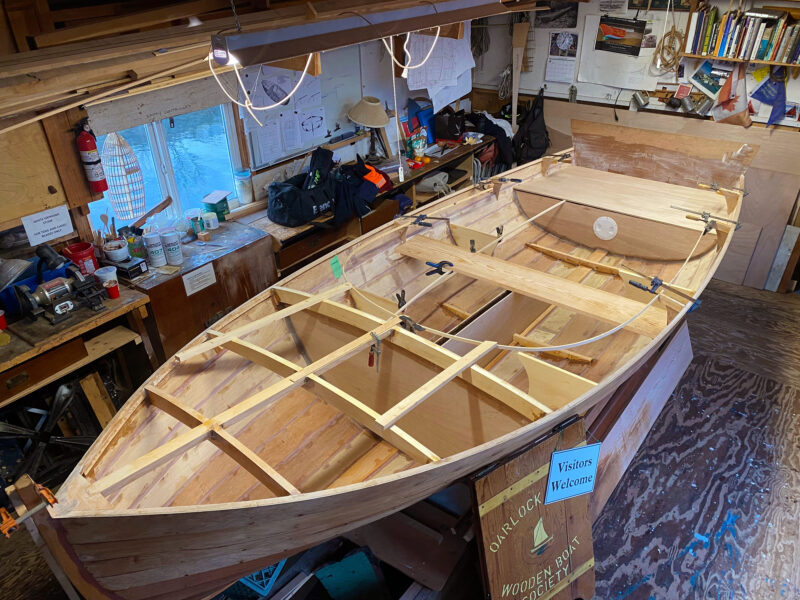 Daniel Friesen
Daniel FriesenOnce the hull was fully planked, we could turn it over and begin work on the interior. As the build came together it was exciting to see the cockpit layout unfold. Oughtred’s plans allow for personal choices, and we made good use of battens and clamps to test shapes and sizes before deciding on final configurations.
We chose the half-decked gunter-sloop version of the Gannet, with some modifications. We lowered the aft deck so that the top of the flotation chamber was at seat height and gave us an additional 18″ of seating, and we reduced the size of the foredeck so that the bulkhead, deck, and coaming were all forward of the mast, lengthening the cockpit space by some 12″. The change in the foredeck meant that the stayed mast was no longer deck-stepped as specified in the plans, but instead was keel-stepped. We keep our club boats in the water year-round, so rigging time is not a concern for us, but in the interest of simplifying the rigging process and to introduce stability, we fit a simple wooden mast partner enclosed by a leather strap that holds the mast to the cockpit coaming—it helps to steady the mast before the shrouds and forestay are rigged.
The gunter rig has a 14′ 6″ mast, shorter than the 19′ 8″ Bermudan option, and even with the 2′ 2″ additional length required for stepping it on the keel we were able to get it and the boom and yard out of some Sitka spruce that we had on hand. Oughtred’s sail plan calls for an 88-sq-ft mainsail and a 32-sq-ft jib. A set of donated sails—made by Macken Sails of Vancouver around 50 years ago—fit our boat nicely. The mainsail is more like a high-peaked gaff than a gunter, so we probably lose a little upwind performance, and the combined sail area is undersized by about 20 sq ft—the mainsail is 77 sq ft, the jib is 32 sq ft. Despite the smaller sails, we built our spars full size so we can upgrade to the designed sail plan if we ever decide it’s necessary. Reef lines are on our to-do list, but we haven’t needed them yet—even singlehanded, the Gannet stands up to an estimated 12- to 14-knot breeze if you’re prepared to hike out.
We considered building the boat in traditional lapstrake (one of the options offered in the drawings) with yellow cedar on steam-bent white oak. Our last couple of new builds have been built this way, but for the Gannet we questioned the traditional construction with the built-in flotation compartments: would a sealed chamber provide adequate ventilation, or would it lead to premature rot? In the end, we decided to go with Oughtred’s preferred glued-plywood lapstrake, both for its light weight and ease of including built-in flotation. Also, it’s a boatbuilding method that our members might be more likely to try if building a boat of their own. For planking and decks we used 1⁄4″ marine plywood, either okoume or meranti; the transom is 3⁄4″ meranti, and the aft deck is 1⁄2″ okoume. The centerboard is two layers of 3⁄4″ meranti, and the rudder is two layers of meranti, one 3⁄4″ the other 1⁄2″. The keel is Douglas fir, the stem is black locust, and the deck framing and floorboards are yellow cedar. Oughtred’s plans do not include material specifications, but the accompanying construction information includes a list of recommendations.
 Daniel Friesen
Daniel FriesenBy lowering the aft deck to seat level and shortening the foredeck we increased the cockpit space so that it will comfortably accommodate four adults under sail. We cut holes in the knees so we could tie things to them—by happy coincidence those same holes were perfect locators for the oars.
Construction went smoothly, and planking progressed quickly—we employed the lattice pattern/spiling or “ladder truss” method of picking up the plank shapes. This method has been described on the WoodenBoat Forum and other online resources, and is mentioned briefly in Oughtred’s manual. Battens are temporarily fastened or clamped to the molds—one along the top edge of what will be the next plank, and one along the bottom. These two battens will define the shape of the plank. They are held in place, relative to each other, by a series of short sticks hot-glued to both and laid zigzag to form a truss. The resulting pattern can then be lifted off the molds and laid flat on the planking stock for the plank to be marked out and cut. We used one pattern per each of the eight pairs of planks and made the patterns alternating on either side of the hull to avoid accumulation of error. When we fitted the planks, we used temporary screws, rather than clamps, along the laps, so that we did not have to wait for the epoxy to cure before starting on the next plank’s pattern. Later, we removed the screws and filled the holes.
With the ample aft flotation chamber and side benches extending the full length of the cockpit as well as a single thwart, the Gannet has plenty of seating options for optimal balance but also enough room to move around. The plans show options for a letterbox slot through the transom for the tiller, or a higher rudderhead that places the tiller above the transom and deck. We chose the taller rudderhead so that we could use a lifting tiller to ease side-to-side movement when the boat is full of crew. As drawn, the tiller is long enough to reach well into the cockpit.
Throughout the construction process we used a 3D computer-modeling program called SketchUp so we could visualize what we were doing before we did it. We imported scans of the lines and construction plans to model the hull by tracing. However, a table of offsets is included on the lines plan for anyone who prefers to loft the lines. We used the computer software initially to consider color schemes for the finish, but then also found it helpful in configuring the floorboard plan, picturing what the revised cockpit would look like, and testing oar length.
It took our club members a little more than 20 months to build the Gannet, with anywhere from six to eighteen people working on the project for a few hours each Saturday. We enjoyed the challenges of the construction (if not the sanding), and Iain Oughtred’s drawings, with all the elements drawn and dimensioned, provided enough information to keep us going; further help was easily found in Clinker Plywood Boatbuilding Manual and online. Having some previous boatbuilding experience was beneficial.
Getting the Gannet ready for sailing is straightforward. We keep it in the water, so the mast is already stepped and rigged. The boom is mounted to the mast with a gooseneck, we have a bridle on the yard and a single halyard, and we have a cunningham to tension the luff. When we return from sailing, we have a topping lift with lazyjacks so that we can support the boom and catch the sail as it is lowered. This makes for an easy harbor furl and keeps the sail out of the cockpit. Stability is excellent when moving around within the cockpit, and although going forward to bend on the jib does cause some tippiness when the crew member goes around the mast, this can be minimized by keeping weight low and movements slow.
The narrow, thin-profile rudder and centerboard were both shaped using NACA (National Advisory Committee for Aeronautics) foil templates as a guide, and under sail the Gannet is extremely responsive to the helm. The drawings show the outline of the rudder and centerboard, but the shaping is left to the builder. The keel is only 3⁄4″ deep and offers little resistance to tacking; if the skipper and crew are in sync, the maneuver can be done in a heartbeat, the boat barely slowing.
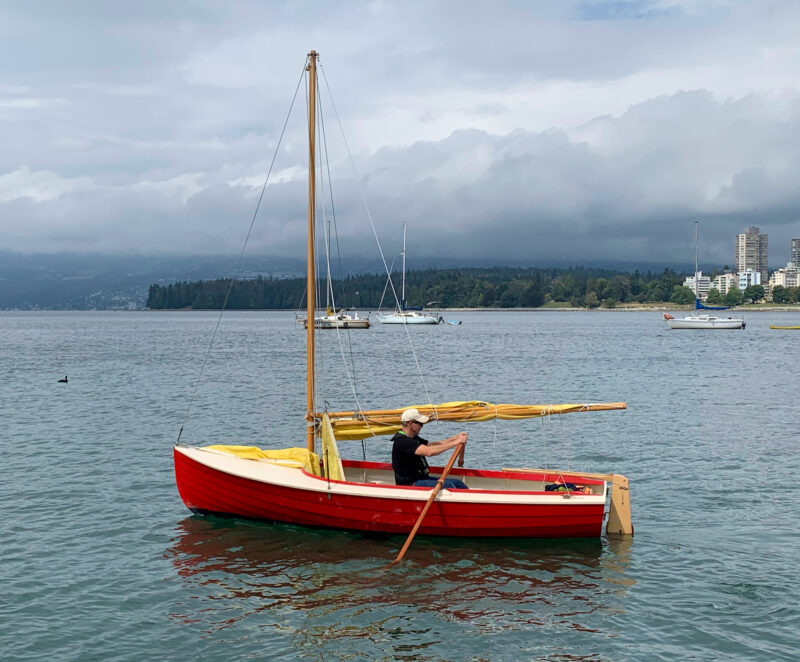 Rob O’Dea
Rob O’DeaWhen rowing, the lazyjacks contain the mainsail, and a bungee holds the tiller amidships. The mainsheet block is located on the centerboard trunk and gets in the way of the rower; to overcome this we unhook it from the boom and stabilize the boom with a temporary line cleated off in the stern.
Vancouver’s outer harbor, where our club members sail, is busy with recreational, fishing, and whale-watching boats, which can generate confused seas. We’ve sailed our Gannet in a variety of conditions, both singlehanded and with as many as four people aboard. With a full crew, as the wind and chop increase, some water does make its way over the forward quarter. With a crew of four in a 13-knot wind gusting to 18 knots and with particularly heavy boat traffic, we maintained a boat speed of 5 to 5 1⁄2 knots. We encountered one particularly large wake with a 3′ trough and took water over the bow, but typically the Gannet takes larger wakes well and, at a decent speed, makes it over waves without porpoising. With only one or two people onboard, it remains dry.
The Gannet is easy to keep flat and is very responsive to weight shifts. We get the best performance with crew weight well forward. We’ve added a simple tiller extension, which makes it possible for the skipper to hike out effectively. We haven’t added hiking straps yet, but so far, hooking our feet under the thwart or the centerboard-trunk rails is serving the purpose.
For rowing, we already had a pair of 8′ 2″ oars that fit the boat nicely. Stowing oars in a small boat can be a challenge, but we discovered that the holes we had cut in the deck knees for securing things just happened to fit the handles of the oars, which then tuck beneath the side deck perfectly.
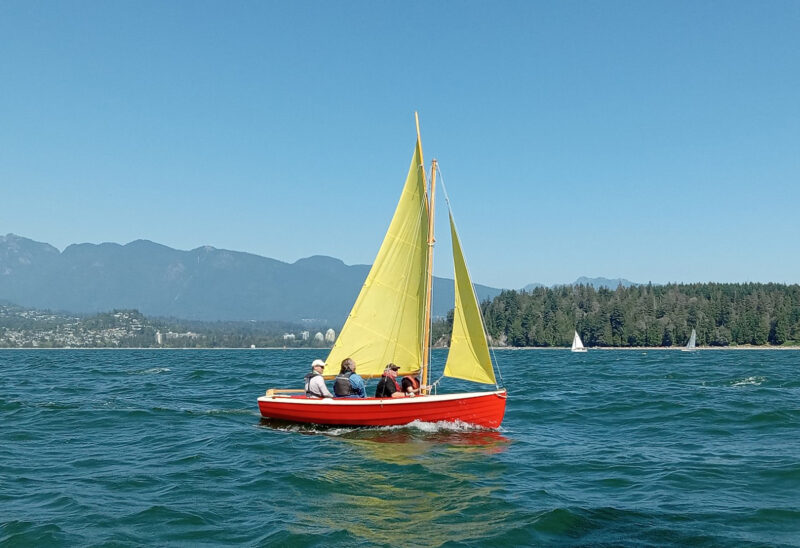 Arnt Arntzen
Arnt ArntzenThe Gannet may only be 14′ but can accommodate four adults in comfort. We have found that with four on board in a stiff breeze with a choppy sea it can be a little wet, but with a crew of two she stays dry whatever the conditions.
Rowing is best done with the centerboard and rudder at least partly lowered because the keel is too shallow to offer any tracking stability on its own. We have found that rowing with the mainsail raised is a challenge. The mainsheet, led to a block mounted on the centerboard trunk, fouls the oars, but we have overcome the problem by running a temporary line farther aft, and unhooking the mainsheet from the boom.
We are more than pleased with the boat, and its ability to carry a crowd. With a lighter load, we’ve been on the verge of planing speed a few times and have enjoyed surfing some larger wakes and waves. We still plan to test the self-rescue behavior, but in the meantime the stability and the way the Gannet handles the winds make us confident that we’re able to avoid the need. The spacious cockpit has some club members dreaming about camp-cruising excursions, and indeed, a drop-in infill between the aft seats would provide a roomy bed. Until then we will enjoy day sails in the harbor, whether relaxing light-wind picnic cruises or more thrilling gallops around the bay!![]()
Daniel Friesen has been a member of Oarlock & Sail Wooden Boat Club for nine years, since first joining and discovering the beauty and satisfaction of being part of building a boat from scratch and then getting out on the water to enjoy it. On the Gannet build he served as lead builder, planning the weekly tasks, arranging for supplies, and ensuring that members were as involved in the work as they wished to be.
Gannet Particulars
LOA: 14′ 5 1⁄2″
LWL: 13′ 10 1⁄2″
Beam: 5′ 7 1⁄2″
Draft: 8″ (3′ 2″ with centerboard down)
Displacement: 900 lbs
Sail area: 120 sq ft (designed gunter rig)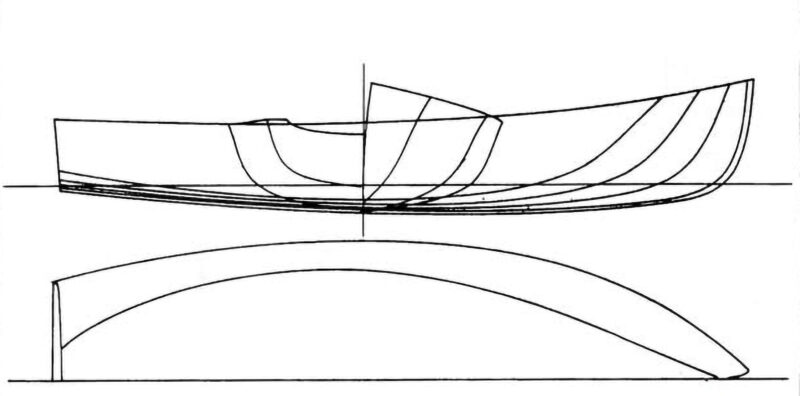
Plans for Iain Oughtred’s Gannet are available from Oughtred Boats priced at $229AUD (within Australia) and $254AUD (the rest of the world); Oughtred Boats also offer Gannet kits starting at $5,888AUD. In the United States kits are available from Hewes and Company, priced at $3,518 for 6mm planking and $3,843 for 9mm planking.
Is there a boat you’d like to know more about? Have you built one that you think other Small Boats readers would enjoy? Please email us your suggestions.
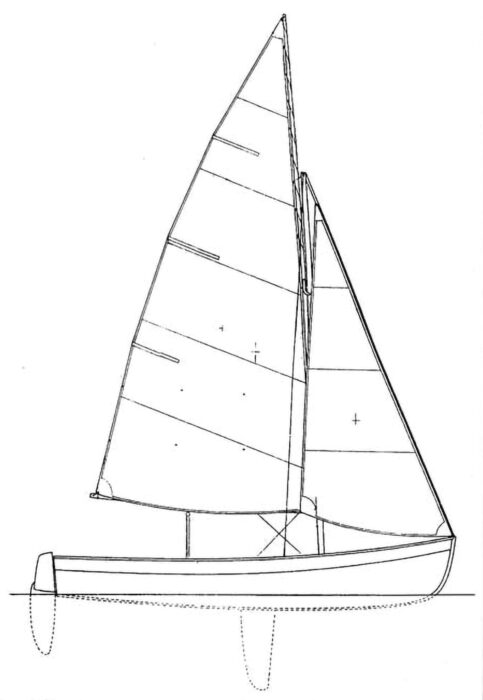
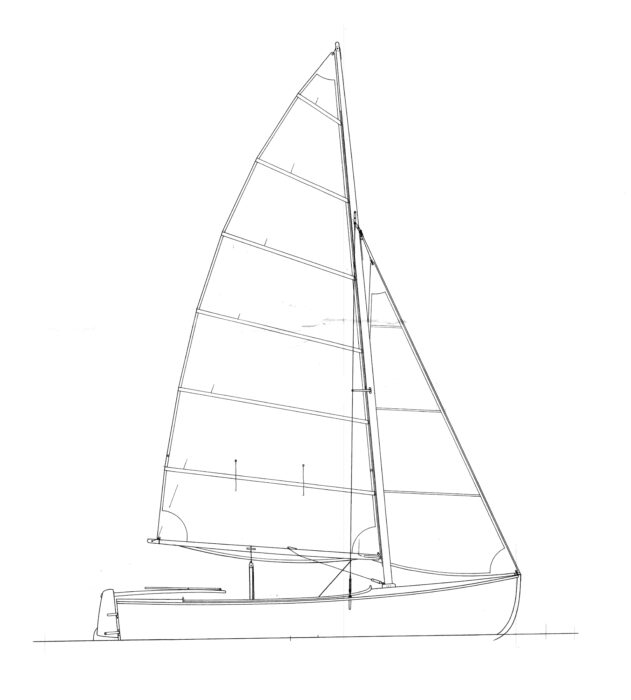
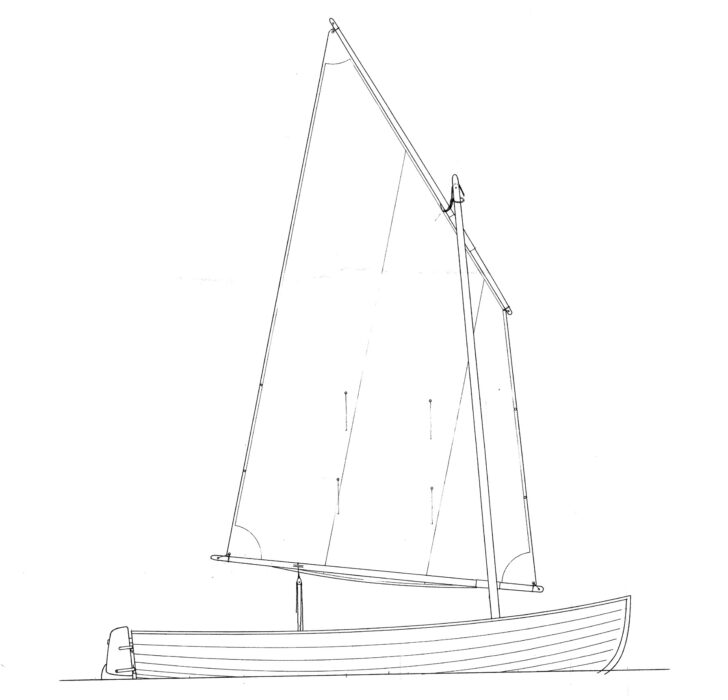
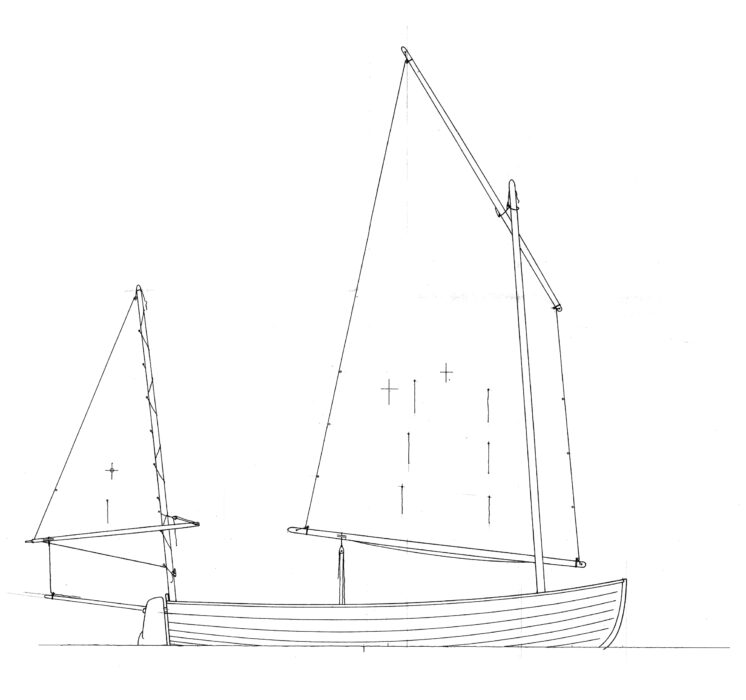
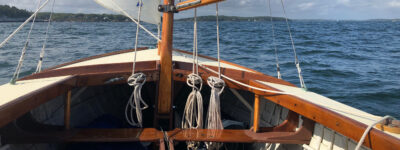
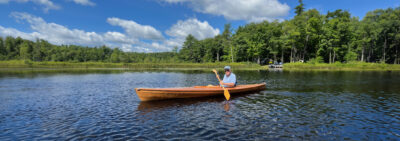
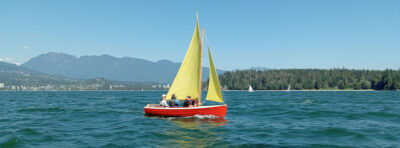


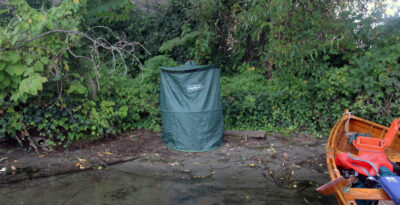


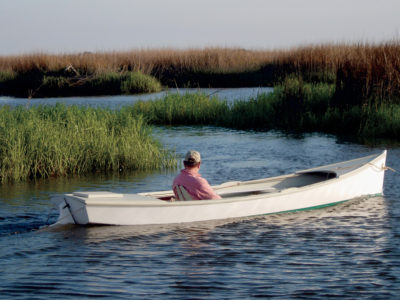
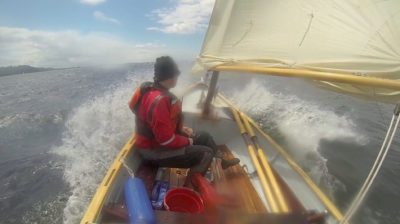
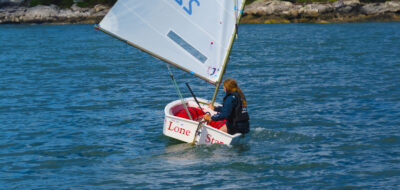
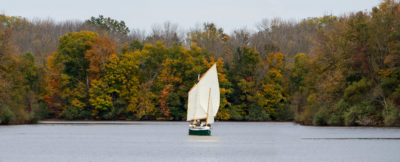
Ian’s design walks us back to the 60s when most of the planing dinghies like Wayfarers were decent day boats. The pre trapeze for everyone days. Test of self rescue would be good, as some of the boats of this era even with self bailing were not easy to self rescue…. think of a Thistle. Keel stepping the mast is an excellent adaptation to the design as it makes it possible to drop the mast if rowing for a day is in the cards: makes camp cruising feasible. Long spars can become bowsprits.
Why is the main sheet attachment canted to the port side?
Hi Cliff, do you mean in the (somewhat messy) interior shot? The mainsheet block is attached to the centreboard trunk with a pad eye and shackle, and is just flopped over.